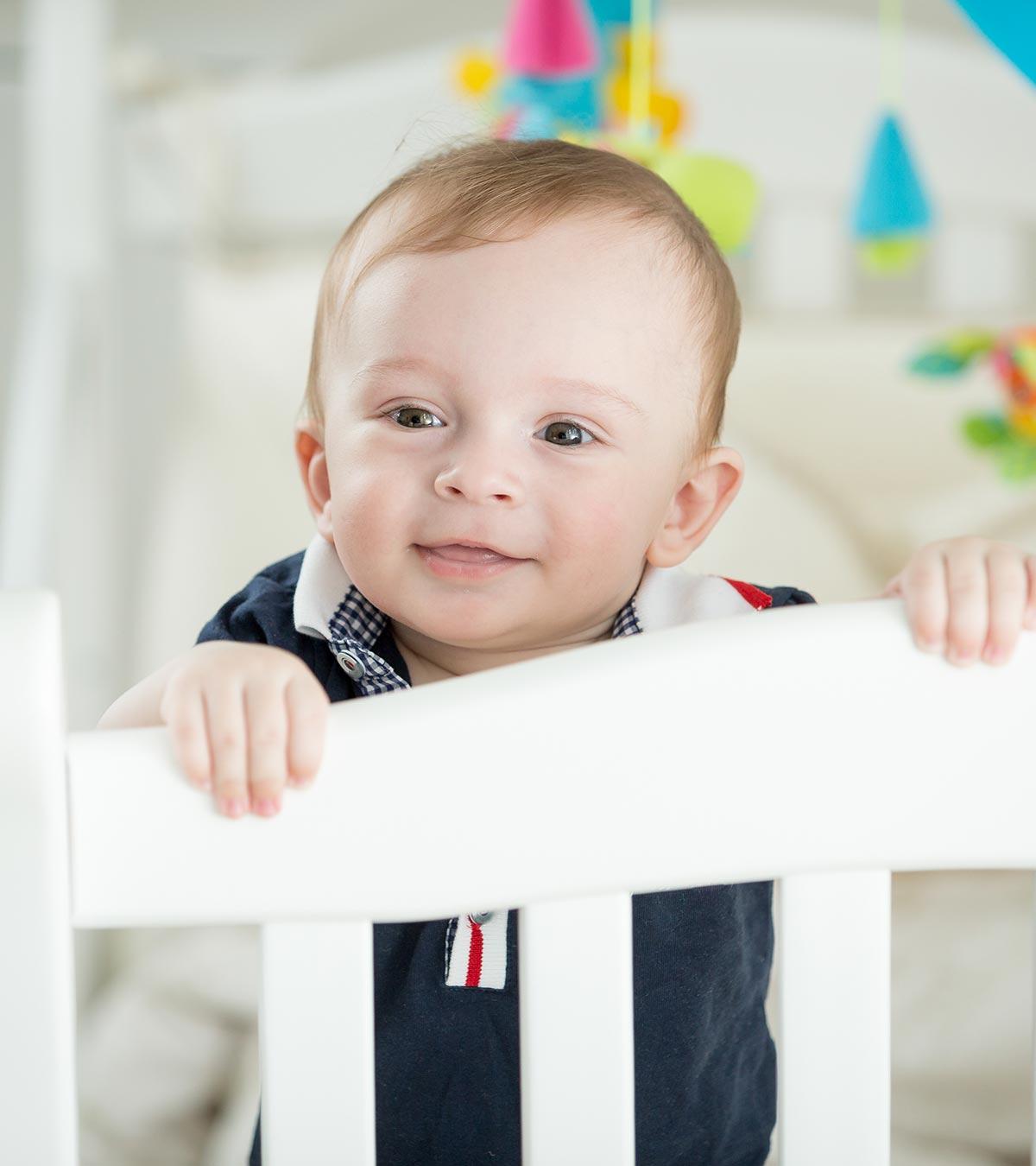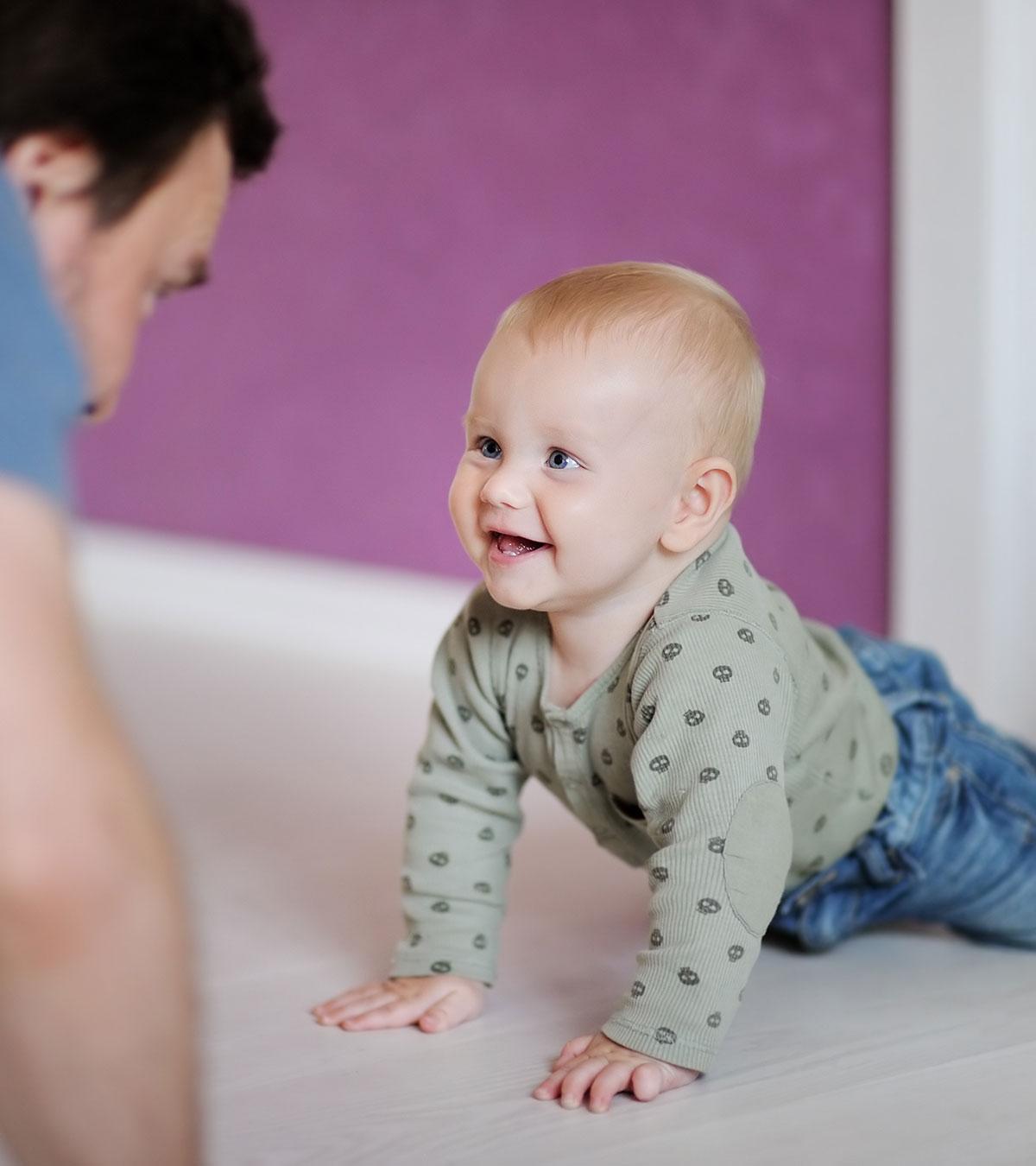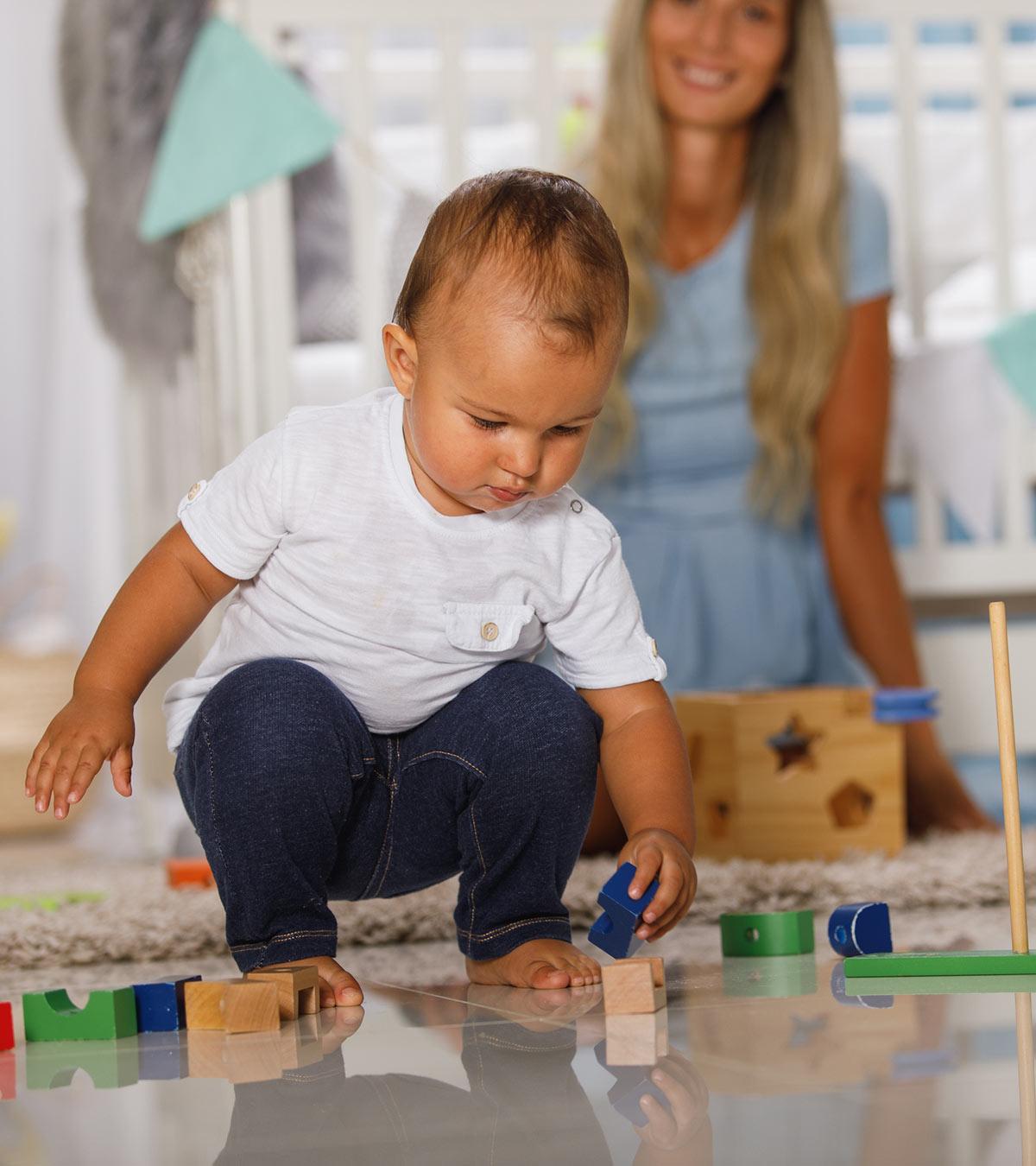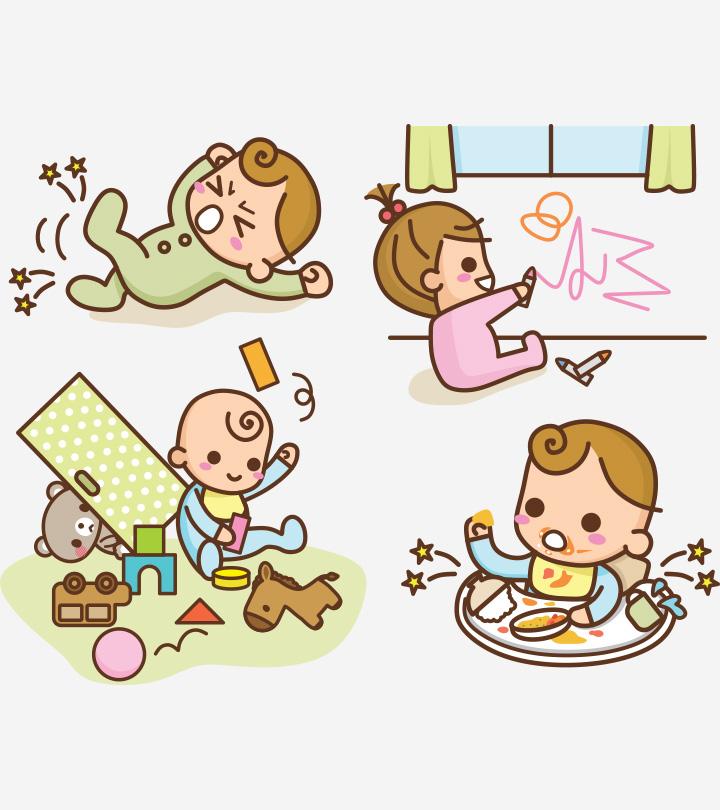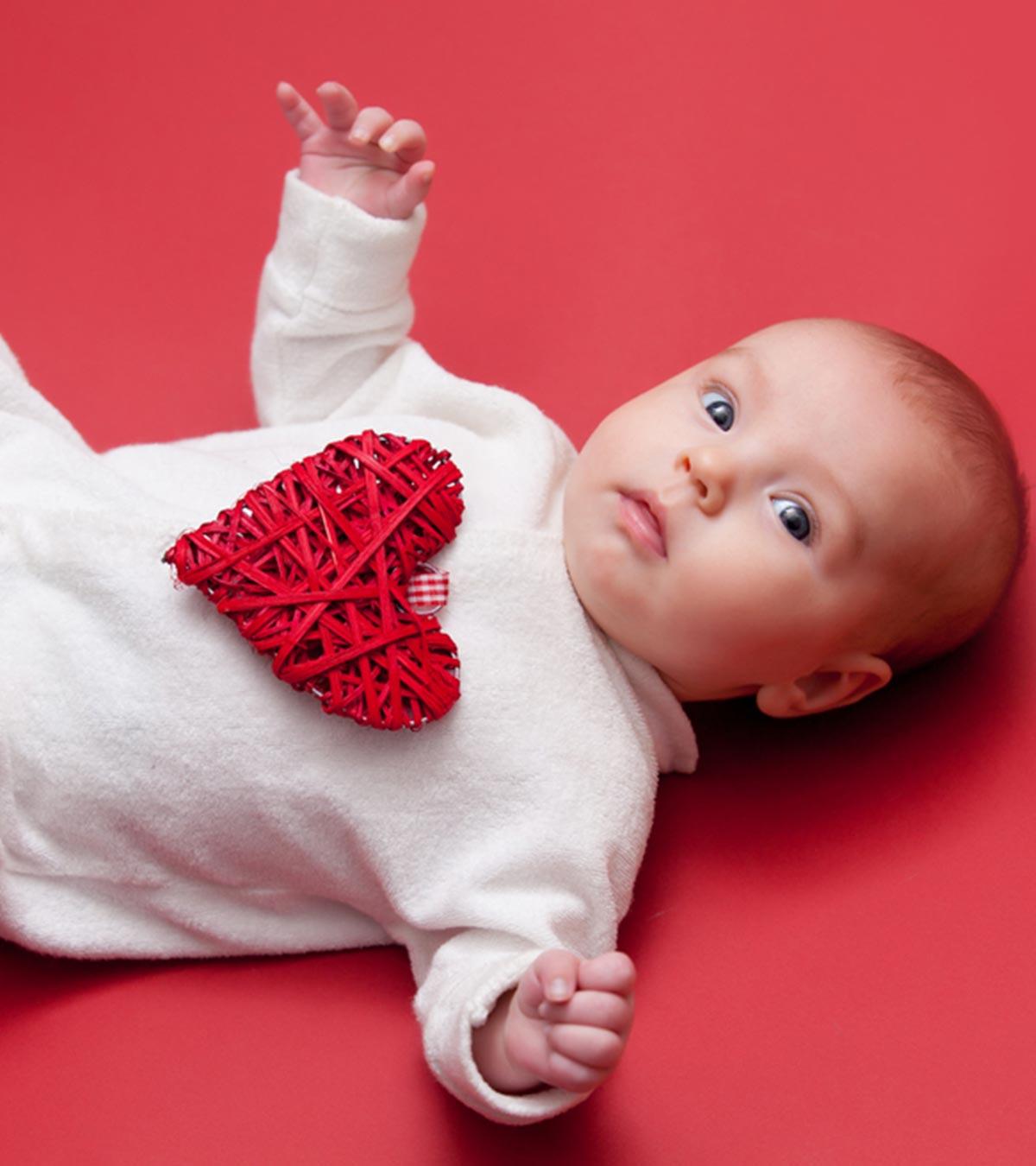
Image: ShutterStock
Many new parents may be curious to know— can newborns see and when they can see clearly? A newborn’s eyes have underdeveloped color vision (1). Vision development is a complex five-step process that gradually occurs over several months before it finally becomes a perfect color vision.
While the baby’s eyes are developing and gaining vision, you should be alert because it gives you a chance to find any developmental issues early. Understanding their vision development is essential for providing the appropriate visual stimuli at each stage, which can greatly impact their overall growth and cognitive development.
Read the post to understand in detail how a baby’s vision develops, signs of vision issues, and the right time to consult a doctor for an eye checkup.
Key Pointers
- Babies develop good color vision and 3-D view by the end of five months.
- At nine to twelve months, children can differentiate between near and far objects and possess excellent eye-muscle coordination.
- Signs and symptoms of vision problems, such as red and swollen eyes, excessive eye turning, shutting eyes in the light, excessive tearing, and the appearance of a white pupil, should not be ignored.
- If your baby has cataracts, blocked tear ducts, amblyopia, strabismus, retinopathy, or ptosis, take them for an eye checkup.
- Premature babies are at risk of developing a condition called retinopathy of prematurity, which can lead to permanent retina damage.
When Can Babies See Clearly?
Babies have good color vision with a three-dimensional view by the end of the fifth month; however, it is still not as sensitive as an adult’s (1). High contrast colors tend to capture the baby’s attention initially.
Your baby’s eyes are capable of seeing properly at birth, but their brain is not yet ready to process and interpret such complex information. The color that babies see at birth is very rudimentary, and their capability to process different shades of a color is limited. Newborn babies’ visual acuity (the clarity or sharpness of vision) is not fully developed, as their fovea and cones are still maturing. This ability develops gradually in infants, and by around one year of age, many babies can see as clearly as adults. However, the newborn’s rods are relatively mature, which makes it easy for them to identify the crude black-and-white images.
But when can babies see color? Your baby will see things in full-color vision through a gradual development of the eye. Since the baby’s eyes are still developing, you must always keep a watch on any probable anomalies.
To do so, it would be wise to first know about the process of vision development in babies.
Vision Development In Babies
Understanding the development of visual processing in newborns can assist parents and caregivers in providing appropriate visual stimulation, supporting healthy eye and brain development.
We have divided the infant vision development into the following age categories:
- Sight at birth (newborn baby)
- Sight from 0-2 months
- Sight from 2 to 4 months
- Sight from 4 to 8 months
- Sight from 9 to 12 months
Newborn Baby’s Eyesight
A newborn’s vision isn’t fully developed and improves over the next few months.
- The primitive eye: Your baby’s eyes start as two small grooves on the developing embryoiThe initial developmental stage of a multicellular organism. , and continue developing from day 22 of your pregnancy (2). This is the precursor organ for the formation of the optic nerve and subsequently, the eye.
- A check for congenital eye disorders: The moment your baby is born, the doctor checks for any congenitaliA trait, disease, or condition present from birth. eye disorders, which are defects that occur in the womb. The doctor may administer some eye drops to inhibit the development of an eye infection.
- How newborns see: At birth, your baby can view objects only in shades of gray, and black and white. This is because the nerve cells in the brain and the eye are yet to develop completely.
- Limited lens focus: The baby will not be able to move the eyes between two target objects and can focus on objects that lie between 8 and 10 inches away from the face (1).
- Refractive errors: Newborn babies will have natural refractive errors in their eyes (3). These are errors for which adults wear glasses. But in babies, this is no cause for worry since the errors happen due to a developing retina and will diminish as they grow. You will also notice that babies respond to bright light by blinking or closing their eyes.
 Did you know?
Did you know?Baby’s Eyesight During 0-2 Months
- Colors babies see first: Your babies see only white, black, and shades of gray during the first few weeks of birth. The eye rods develop within the second and third month. Babies will then start seeing large geometric patterns in bright colors. Towards the end of this development, they start seeing the colors red and green. You may introduce large black and white toys to your babies at this time.
However, they still cannot differentiate between similar-looking colors such as red and orange. This means they can interpret a color but can’t differentiate between the various shades (light green and very light green). At the age of five and six months, your baby will start differentiating between dark and light colors (4).
- May give blank expressions: An enticement towards high contrast colors means that the baby will look straight into your eyes, but their brain cannot process visual data completely. Therefore, do not fret if the baby gives a blank expression if you smile or wink at them.
- Dilated pupils: Your baby’s pupils are constricted for the first two weeks to restrict the entry of light since the retina is still sensitive. It is only after the third week that their pupilsiThe black part of the eye. begin to dilate to let more light in (4). Weeks after the birth, you will notice that babies open their eyes for more definite time intervals.
- Blurry vision: For the first month, your newborn’s vision will be blurry. Although they may focus on nearby objects, distant objects remain unclear. Objects will have to be big, bold and colorful to elicit a response from a baby (3).
- Vision-hearing coordination develops: By the end of the first month, babies will have decent vision-hearing coordination. This means if you play a rattle in front of them (at a distance of 8-10 inches), they will respond by looking at it (1).
- Peripheral vision develops: Babies will have good peripheral vision and will briefly be able to focus on an object placed peripherally (4).
- Learning to focus: Your baby’s eyes will appear to wander independently, and the baby may appear cross-eyed. This is normal since the baby is still learning to focus on objects (1).
- Color clarity: By the end of the second month, the baby will be able to discern between shades of color. They will show a preference towards brighter shades of colors. That’s why baby toys are so vividly colorful (4).
- Mommy is smiling: Babies can now interpret a smile on a parent’s face. At two months, your infant will respond to your smile with an adorable smile (5). This is an indicator that your newborn’s eyesight can focus on specific objects in the environment.
A baby’s vision is much more developed now than what it was at the time of birth
. Thus, now is the time that you could consult your pediatrician and try the following steps to support your baby’s eye development (1) (4).
- Use high-contrast pattern toys and place them about 10 inches away from the baby when they are playing.
- Use dim artificial lighting in the baby’s room. Sharp lights would cause disturbance.
- Young babies usually see their mother’s face while breastfeeding, so keep alternating the sides while feeding so that the baby gets to see you from both the eyes.
- When the baby is a month-and-a-half old, play a simple stare game. Hold your baby seven inches away and look into their eyes. Once they see straight into your eyes, move slowly from side to side. They should follow you with their gaze. This makes a great eye exercise for your baby.
- By the time the baby is two months old, they will smile and respond to your facial expressions. Make it a point to look straight into their eyes and smile or talk. This will help improve their focus and visual attention.
Baby’s Eyesight At 2-4 Months
- Improved depth perception: During this period, your baby’s depth perception will improve, which means they can judge how far an object is from them. This is also due to an improvement in the overall coordination between the eyes and brain (4).
- Tracking objects: Babies can now track moving objects better. If something changes position in their field of vision, they will move their eyes to look at it. They will keenly watch any activity around them. Move a rattle in their field of vision, and they will gaze along the moving rattle. This skill is known as visual tracking (1).
- More colors! The number of colors in your baby’s vision palette has now increased (4).
- How far can a 4 month-old see? By the end of the fourth month, babies develop a better view of distant objects. Now when they sit in front of the window, they see through the glass pane rather than focus on the glass.
A baby’s binocular vision (ability to use both eyes together) develops gradually over the first few months of life. The baby is developing depth perception and can track objects. So now, you can gear up a bit and work on the baby’s color vision and overall eye control. To do that, the following steps could be taken.
- Your baby’s color vision develops during this period. Introduce them to colorful objects and toys that are painted in vivid colors.
- A baby gym is a great place for them to exercise their eyes and develop ocular motor control. You can place different types of dangling toys and let them look and touch them all while lying on their backs.
Baby’s Eyesight At 4-8 Months
- The colorful world: By the fifth month, your baby’s color vision is robust (1).
- Remembers faces: Depth perception, visual memory, and object familiarity improve. They instantaneously recognize familiar faces and objects lying even six feet away (4).
- Object permanence: Their vision is now slowly transitioning to that of an adult. They view smaller details and understand the coherent permanenceiConsistent and permanent presence of an object. of objects. This means if you hide a toy under a blanket right in front of them, they will know that the toy exists right there (6).
Between four and eight months, babies can be supported for the development of their visual stimulus skills
. The following steps involve the addition of more color to your baby’s toy collection to help develop their visual perception.
- Give babies colored blocks to play with. Bring them a basket of fruits and let them see all the vibrant natural colors.
- Play a hidden objects game, and games like hide and seek. You can also play mini treasure hunt games, which will stimulate them to respond to a visual stimulus.
- Toys with bright colors and high contrast patterns will still be their favorites. Therefore, introduce them to patterns that will entice them and hold their visual attention longer.
Baby’s Eyesight At 9-12 Months
This is the time when your baby finally sees the way an adult sees
. There is now a fully developed color vision, and depth perception is much better.
- Eye color permanence: Your baby’s eye color is almost close to the final color that the eyes will have for the rest of their life.
- Can tell near-far objects: By the time they complete a year in their life, your baby has an adult vision –they can differentiate between near and far, tell colors apart, see an object at a distance, and recognize familiar faces and objects (4).
- Eye-muscle coordination: They will have better coordination between their muscles and vision. Since their muscles are still developing, they may appear clumsy in their movement, but their vision per se would be developed.
It’s the time for helping your baby develop eye-muscle coordination. This is also the time when the baby may be supported to recall the visuals by pointing at drawings and human faces.
- Include moving object games in their playtime. Play simple games with a throw ball and toys attached to the string.
- Have story time sessions where you open a brightly colored and illustrated book in front of them and read through it. Encourage them to point toward the drawing, and prompt them to say its name.
- Babies love human faces, so have as much family bonding as you can. It is a great way to stimulate their ability to learn and recall new faces.
A regular eye checkup is always recommended for the general well-being of your little one. Chalking out the signs and symptoms well in time could help in avoiding complications. Below is a list of signs and symptoms which should be checked.
Signs Of Eye And Vision Problems
Vision problems could lead to developmental issues. Therefore, it is important to watch for the signs and symptoms to act well in time (7).
- Red or swollen eyelids: This could indicate an infection or allergy.
- Excessive eye turning: The ocular or eye muscles are still developing. Therefore, the baby’s eyes may appear to move independently. But if the movement is constant and too extreme, then it could indicate a problem.
- Too sensitive to light: If your baby shuts eyes whenever you both are stepping out in the sun, then this could be an indication that the baby may have a pressure problem in the eye or an issue with the retinal cells.
- Excessive tearing: The tear glands in babies are still developing. Therefore, they may suffer from conditions like excessive tearing or blockage.
- The appearance of a white pupil: This could mean anything from cancer to cataract, so it is something that requires prompt medical attention.
 Quick fact
Quick factWhen Should You Take Your Baby For Eye Checkup?
The following are common eye ailments found in babies. These can be detected through regular eye checkup:
- Cataracts: The eye lens of newborns is clear like that of adults. But in some rare cases, the baby may be born with cloudiness in their lens, which is referred to as a cataract. A cataract is usually spotted immediately after birth or a few weeks after a medical checkup by a pediatrician. CataractsiA cloudy lens diminishing the vision. can be rectified with surgery that is quite similar to the one done for adults (8).
- Blocked tear ducts: Sometimes, a baby can be born with a blocked tear duct that can cause swelling and redness around the lower or upper eyelid (9). Infants have an underdeveloped immune system, and an inflamed tear duct can become a breeding ground for bacteria. Prompt antibiotic intervention can avoid the risk of the baby losing vision.
- Amblyopia: This is also referred to as lazy eye syndromeiAn early childhood condition where the brain fails to process the input from one eye. . In this condition, the baby loses vision in one eye due to a lack of use. The condition is caused due to numerous reasons, from the basic lack of brain-eye coordination to a crossed eye. As per a report by National Eye Institute, this condition affects 3 out of 100 children. Amblyopia can be tough to detect since both eyes look perfectly healthy and normal. A regular checkup with an ophthalmologist should help detect the condition early (10).
- Strabismus: In the first four months, your baby’s eyes appear to move independently, without coordination. From the fifth month, the ocular muscles develop coordination. In case your baby shows chronic eye misalignment even in the sixth month, then it could be a sign of strabismus, commonly called a crossed eye squint (11). In some cases, the symptoms may present even after the baby’s first birthday. Sabrina Bryant, a mother to a son, noticed her son’s strabismus at 16 months. She shares, “When my baby was about sixteen months old, I started noticing that his left eye was turning too…The doctor told me everything looked fine. They told us to come back in three months if I still felt there was a problem. Three months passed, and the turn did not correct itself and even began to turn more often. So back we went to the Institute, and a different doctor examined him…she hit me with the same come back sooner if I felt the turn was getting worse. She (the doctor) prescribed these glasses with a prism inside the lens and taught us eye muscle-strengthening exercises. For six months, he (my son) wore his glasses, but it didn’t seem to help much. We even did all the eye exercises (i).” Bryant ultimately took her son to a specialist who acknowledged it was strabismus and performed surgery to correct the condition.
- Retinopathy: Retinopathy is the damage to the retina when the baby is born prematurely. It occurs as the blood vessels in the retina are not formed completely or have abnormal development. Retinopathy in babies can be easily detected by a doctor during an ophthalmic examination (12).
- Ptosis: The eyelids are held in place by muscles. In some cases, a baby may be born with an underdeveloped eyelid muscle that will cause the eyelid to droop involuntarily. This condition is referred to as Ptosis. Ptosis itself may not be a threat, but it can lead to Amblyopia, which in turn can cause vision loss in the eye with the droopy eyelid. Thankfully, Ptosis can be easily spotted, and corrective surgery can fix it (13).
Premature Baby Eyesight Development
Premature babies have critically underdeveloped organs, including eyes. This puts them at a higher risk of complications when it comes to visual development. Through care and medication, their vision development can be aligned with that of regular babies.
Premature babies run the risk of developing a condition called retinopathy of prematurity. It leads to the damage of the retina, which can be permanent. What escalates the risk in premature babies, apart from underdeveloped eyes, is the excess use of oxygen due to poorly developed lungs that are not yet capable of separating oxygen from the air. Excess oxygen interferes with the development of the blood vessels that supply blood to the retina (14).
RetinopathyiA disease affecting the retina’s red blood cells and impacting vision. of prematurity can be treated during the general course of care and nursing of a premature baby.
Frequently Asked Questions
1. Are there any early vision problems that can affect babies?
Babies can have vision problems, and some of the most frequent eye issues in children are lazy eyes, crossed eyes, droopy eyelids, nearsightedness, farsightedness, astigmatism, cataracts, and retinopathy of prematurity (16).
2. What eye tests should I do for my baby?
Doctors recommend the first eye tests at six months, including pupil responses, fixate and follow, and preferential looking, which determine whether the baby can focus, see colors, and perceive depth (17).
3. What are the long-term effects of poor vision in babies?
Poor vision may lead to potential physical harm due to falling and reduced quality of life. It also impacts mental health, causing loneliness, social isolation, and anxiety (18).
4. How long does it take for a baby to develop 20/20 vision?
Babies’ eyesight and skills improve in the first three months of life. By the time a 6 month old baby reaches this milestone, they typically develop 20/20 vision, allowing them to see things clearly and distinguish between different colors (19).
5. What development activities can help improve a baby’s vision?
In the first four months of life, move the crib and toys around, and talk to your baby. From 4 to 8 months, encourage crawling and visual exploration, play games, and hang objects across the crib. Don’t rush walking from 8 to 12 months; provide stacking and take-apart toys. From 1 to 2 years, encourage walking and opportunities to climb and explore safely (20).
6. How long does it take for babies to focus on objects?
Babies usually can focus and follow objects by the end of four months. As they grow older, they learn to coordinate their hands and eyes and judge distances (20).
7. How soon can babies recognize familiar faces?
Babies may seem more aware of caregivers from a few weeks but usually recognize faces by the time they are three months old (21).
A baby’s eyesight development starts with the baby attaining primitive eyes during their fetal life, leading to the formation of fully formed eyes gradually. Newborns usually have a foggy vision and insufficient eye control. Once they are a couple of months old, they have better depth and color perception. Your baby’s vision is almost adult-like by the time they are 9-12 months old. During these developments, it is important to look out for any symptoms that may hinder the development process and seek medical help. In addition, regular eye checkup is important for timely detection of common eye problems such as cataracts or blocked tear ducts.
 Quick tip
Quick tipInfographic: How Can Parents Aid In Their Baby’s Vision Development?
During the first few months of life, babies undergo several developments in their visual abilities. As parents, you can help in the development of their visual abilities by encouraging certain activities in day-to-day life. Educate yourself about the same with the help of this infographic. Illustration: Momjunction Design Team
Illustration: When Can Babies See Clearly And Their Vision Development
Image: Stable Diffusion/MomJunction Design Team
Watch how your newborn’s vision develops over the first year after birth in this interesting and informative video.
Personal Experience: Source
MomJunction articles include first-hand experiences to provide you with better insights through real-life narratives. Here are the sources of personal accounts referenced in this article.
i. My son and I had strabismus surgery done on the same day.https://medium.com/becoming-better/my-son-and-i-had-strabismus-surgery-done-on-the-same-day-a21ddfa3ef73
References
- Infant Vision: Birth to 24 Months of Age; American Optometric Association
https://www.aoa.org/healthy-eyes/eye-health-for-life/infant-vision - Embryology, Eye
https://www.ncbi.nlm.nih.gov/books/NBK538480/ - Your Baby’s Hearing Vision and Other Senses; 1 Month; Nemours KidsHealth
https://kidshealth.org/en/parents/sense13m.html - Infant Vision: Birth to 24 Months of Age; American Optometric Association
https://www.google.com/url?q=https://www.aoa.org/patients-and-public/good-vision-throughout-life/childrens-vision/infant-vision-birth-to-24-months-of-age&sa=D&source=docs&ust=1676545360547717&usg=AOvVaw1_b9I-U5X49MoTSEWbO0HM - Important Milestones: Your Baby By Two Months; Centers For Disease Control And Prevention
https://www.cdc.gov/ncbddd/actearly/milestones/milestones-2mo.html - Separation Anxiety; Nemours KidsHealth
https://kidshealth.org/en/parents/sep-anxiety.html - Warning Signs of Vision Problems in Infants & Children; Healthy Children; American Academy of Pediatrics
https://www.healthychildren.org/English/health-issues/conditions/eyes/Pages/Warning-Signs-of-Vison-Problems-in-Children.aspx - Treatment-Childhood cataracts; National Health Service UK
https://www.nhs.uk/conditions/childhood-cataracts/treatment/ - What Is a Blocked Tear Duct?; American Academy of Ophthalmology
https://www.aao.org/eye-health/diseases/what-is-blocked-tear-duct - Amblyopia; Boston Children’s Hospital
http://www.childrenshospital.org/conditions-and-treatments/conditions/a/amblyopia - Crossed-Eyes (Strabismus); Stanford Children’s Health
https://www.stanfordchildrens.org/en/topic/default?id=crossed-eyes-strabismus-90-P02109 - Retinopathy of Prematurity; National Eye Institute
https://www.nei.nih.gov/learn-about-eye-health/eye-conditions-and-diseases/retinopathy-prematurity - Ptosis – infants and children; Medline Plus; U.S National Library of Medicine
https://medlineplus.gov/ency/article/003035.htm - Retinopathy of prematurity; National Library of medicine
https://medlineplus.gov/ency/article/001618.htm - Infant Vision Birth to One Year
https://www.nationwidechildrens.org/family-resources-education/health-wellness-and-safety-resources/helping-hands/infant-vision-birth-to-one-year - Common Pediatric Eye Problems
https://dmei.org/services-specialties/pediatric-ophthalmology-strabismus/common-pediatric-eye-problems/ - Eye Exams for Children
https://www.optometrists.org/childrens-vision/guide-to-childrens-eye-exams/pediatric-eye-exams-2/ - About Vision Loss and Mental Health
https://www.cdc.gov/vision-health/about-eye-disorders/vision-loss-mental-health.html?CDC_AAref_Val=https://www.cdc.gov/visionhealth/resources/features/vision-loss-mental-health.html - Eye Development in Babies
https://www.chla.org/eye-development-babies - Ways to Help Infant Vision Development
https://infantsee.aoa.org/parents-center/parents/ways-to-help-infant-vision-development?sso=y - Child development 0–3 months
https://www.healthywa.wa.gov.au/Articles/A_E/Child-development-0-3-months
Community Experiences
Join the conversation and become a part of our nurturing community! Share your stories, experiences, and insights to connect with fellow parents.
Read full bio of Dr. Mukul Kumar Mangla
Read full bio of Rohit Garoo
Read full bio of Dr. Ritika Shah
Read full bio of Vidya Tadapatri















